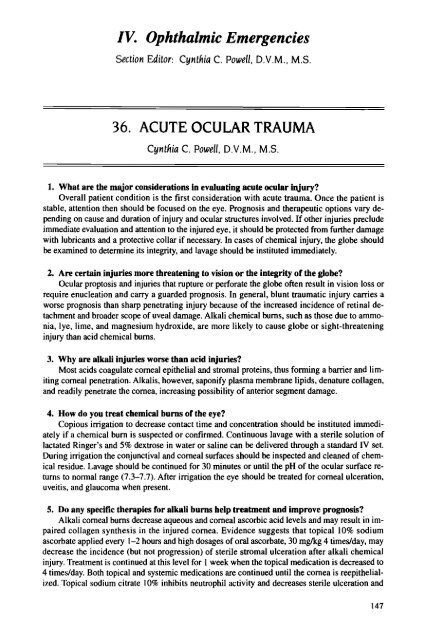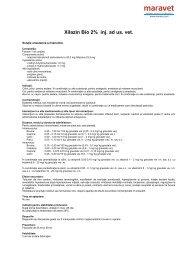- Page 2 and 3:
Publisher: HANLEY & BELFUS, INC. Me
- Page 4 and 5:
xii Contributors Michael R. Lappin,
- Page 6 and 7:
DEDICATION To my residents in emerg
- Page 8 and 9:
I. Life-threatening Emergencies Sec
- Page 10 and 11:
Decision Making in Veterinary Emerg
- Page 12:
4 Cardiopulmonary Arrest and Resusc
- Page 15 and 16:
Cardiopulmonary Arrest and Resuscit
- Page 17:
Cardiopulmonary Arrest and Resuscit
- Page 21 and 22:
Cardiopulmonary Arrest and Resuscit
- Page 23 and 24:
Respiratory Distress 15 6. Blumenth
- Page 25 and 26:
16 Respiratory Distress Hyperventil
- Page 27 and 28:
18 Respiratory Distress Chest wall.
- Page 29 and 30:
20 Respiratory Distress 20. What ar
- Page 31 and 32:
4. PATHOPHYSIOLOGY OF CONGESTIVE HE
- Page 34 and 35:
Pathophysiology of Congestive Heart
- Page 36 and 37:
Class I Class II Class III Class IV
- Page 38 and 39:
Shock 29 5. During the course of th
- Page 40 and 41:
Shock 31 15. Blood flow to which or
- Page 43 and 44:
34 Shock administration of general
- Page 45 and 46:
36 Shock Often the infusion of a sy
- Page 47 and 48:
38 Acute Gastric Dilatation-Volvulu
- Page 49 and 50:
40 Acute Gastric Dilatation-Volvulu
- Page 52 and 53:
Anaphylaxis 43 obstruction, profuse
- Page 54 and 55:
44 Hypothermia bronchoconstriction,
- Page 56 and 57:
46 Hypothermia 11. What cUnical fin
- Page 58 and 59:
48 Heat Stroke across ischemia-dama
- Page 60:
Heat Stroke 49 of environmental tem
- Page 63 and 64:
52 Heat Stroke BIBLIOGRAPHY I. Bouc
- Page 65 and 66:
54 Treatment Priorities in Trauma S
- Page 67 and 68:
56 Treatment Priorities in Trauma 1
- Page 69 and 70:
58 Arterial Bleeding 9. Should a to
- Page 71 and 72:
12. RESPIRATORY EMERGENCIES Elisa M
- Page 73 and 74:
62 Respiratory Emergencies 15. Name
- Page 75 and 76:
64 Respiratory Emergencies 27. What
- Page 77 and 78:
Traumatic Myocarditis 65 • Loss o
- Page 79 and 80:
Traumatic Myocarditis 67 therapy. I
- Page 81 and 82:
68 Fluid Selection in Trauma BIBLIO
- Page 83:
70 Fluid Selection in Trauma 11. Wh
- Page 86 and 87:
Fluid Selection in Trauma CONTROVER
- Page 88:
74 Blood Transfusions 8. Mandell DC
- Page 91 and 92:
Blood Transfusions 77 17. Can trans
- Page 93 and 94:
78 Brain Injuries II. Purvis 0: Aut
- Page 95 and 96:
80 Brain Injuries The Small Animal
- Page 97 and 98:
82 Brain Injuries Examination ofthe
- Page 99 and 100:
84 Brain Injuries 24. Should mannit
- Page 101 and 102:
Acute Spinal Cord Injuries BIBLIOGR
- Page 103 and 104:
Acute Spinal Cord Injuries 87 11. W
- Page 105 and 106:
Peripheral Nerve Trauma 89 22. What
- Page 107 and 108:
90 Peripheral Nerve Trauma o Neurot
- Page 109 and 110:
92 NERVE Pudendal SI-S3 Pelvic plex
- Page 111 and 112:
94 Extremity Trauma 8. What is a gr
- Page 113 and 114:
20. ABDOMINAL INJURIES Wayne E. Win
- Page 115 and 116:
98 Abdominal Injuries 11. Which oth
- Page 117 and 118:
Pain Management in Emergencies 99 a
- Page 119 and 120:
Pain Management in Emergencies 101
- Page 121 and 122:
Pain Management in Emergencies 103
- Page 123 and 124: Pain Management in Emergencies 105
- Page 125 and 126: 22. DISASTER PREPAREDNESS AND THE V
- Page 127 and 128: Disaster Preparedness and the Veter
- Page 129 and 130: Ill. Common Primary Complaints Sect
- Page 131 and 132: PRIMARY GI DISORDERS Obstructions (
- Page 133 and 134: 114 Diarrhea idiopathic vestibular
- Page 135 and 136: 116 Diarrhea 9. What are the potent
- Page 137 and 138: Syncope vs. Seizures 117 3. Jergens
- Page 139 and 140: 26. ATAXIA Tim Hackett, D.V.M., M.S
- Page 141 and 142: 27. ANOREXIA Tim Hackett. D.v.M., M
- Page 143 and 144: Anorexia 123 10. Should anorexia be
- Page 145 and 146: 124 Fever BIBLIOGRAPHY I. Barrett R
- Page 147 and 148: 126 Stranguria during fever, can be
- Page 149 and 150: Stranguria 127 • Urinary tract in
- Page 151 and 152: Stranguria 129 and cats is transiti
- Page 153 and 154: Obstipation and Constipation 131 11
- Page 155 and 156: 132 Obstipation and Constipation Co
- Page 157 and 158: Fractured Tooth Drugs Used for Chro
- Page 159 and 160: Abscesses and Cellulitis 135 and up
- Page 161 and 162: 136 Abscesses and Cellulitis 5. How
- Page 163 and 164: Rattlesnake Envenomation 137 11. Wh
- Page 165: Rattlesnake Envenomation 139 Rattle
- Page 168 and 169: 142 Lameness 5. What is the Ortolan
- Page 170 and 171: 144 Infectious Disease fluid therap
- Page 172 and 173: Infectious Disease 145 2. How can t
- Page 176 and 177: Acute Ocular Trauma 149 11. How is
- Page 178 and 179: Acute Ocular Trauma 151 deep stroma
- Page 180 and 181: 152 Ocular Hemorrhage removal, trea
- Page 182 and 183: 154 Ocular Hemorrhage 7. What cyclo
- Page 184 and 185: 156 Sudden Blindness orders such as
- Page 186 and 187: Sudden Blindness 157 poorly respons
- Page 188 and 189: Uveitis 159 3. Krohne SD, Vestre WA
- Page 190 and 191: 160 Uveitis 9. What are the major c
- Page 192 and 193: 162 Uveitis 14. What significance c
- Page 194 and 195: Glaucoma 163 2. Bistner S, Shaw D,
- Page 196 and 197: Glaucoma 165 true for plunger loads
- Page 198 and 199: Vision-threatening Corneal Ulcers B
- Page 200 and 201: 168 Vision-threatening Corneal Ulce
- Page 202 and 203: v. Respiratory Emergencies Section
- Page 204: 172 Allergic Airway Disease in Cats
- Page 209 and 210: 176 Dirofilariasis necessary not on
- Page 211 and 212: Dirofjlariasis 177 through the host
- Page 213 and 214: Dirofilariasis 179 19. How frequent
- Page 215 and 216: 45. PULMONARY THROMBOEMBOLISM Elisa
- Page 217 and 218: Pulmonary Thromboembolism 183 17. W
- Page 219 and 220: 184 Laryngeal Paralysis 25. What ca
- Page 221 and 222: 186 Laryngeal Paralysis • Aryteno
- Page 223 and 224: Near Drowning 187 13. Schachter S,
- Page 225 and 226:
Pulmonary Edema 189 16. What monito
- Page 227 and 228:
190 Pulmonary Edema 3. Describe the
- Page 229 and 230:
192 Pulmonary Edema thereby decreas
- Page 231 and 232:
49. HEMOPTYSIS Wayne E. Wingfield,
- Page 233 and 234:
50. SMOKE INHALATION AND BURN INJUR
- Page 235 and 236:
198 Smoke Inhalation and Burn Injur
- Page 237 and 238:
VI. Cardiovascular Emergencies Sect
- Page 239 and 240:
202 Mitral Valve Insufficiency Due
- Page 241 and 242:
204 Dilated Cardiomyopathy tachyarr
- Page 243 and 244:
206 Dilated Cardiomyopathy function
- Page 245 and 246:
208 Dilated Cardiomyopathy Digoxin
- Page 247 and 248:
210 Dilated Cardiomyopathy Devices
- Page 249 and 250:
Cardiac Arrhythmias 211 14. Sisson
- Page 251 and 252:
Cardiac Arrhythmias 213 3. Holter m
- Page 253 and 254:
Cardiac Arrhythmias 215 2. Frequenc
- Page 255 and 256:
Cardiac Pacemakers 217 Electrocardi
- Page 257 and 258:
Pericardial Effusion BIBLIOGRAPHY I
- Page 260 and 261:
Pericardial Effusion 221 effusion a
- Page 262 and 263:
Pericardial Effusion 223 23. What a
- Page 264 and 265:
Feline Myocardial Disease 225 felin
- Page 266 and 267:
Feline Myocardial Disease 227 prece
- Page 268 and 269:
Feline Myocardial Disease 229 befor
- Page 270 and 271:
Feline Myocardial Disease 231 diagn
- Page 272 and 273:
232 Systemic Arterial Thromboemboli
- Page 274 and 275:
234 Systemic Arterial Thromboemboli
- Page 276 and 277:
236 Neutropenia, Sepsis, and Thromb
- Page 278:
238 Neutropenia. Sepsis, and Thromb
- Page 281 and 282:
Neutropenia, Sepsis, and Thrombocyt
- Page 283 and 284:
Coagulation Disorders 243 renal dys
- Page 285 and 286:
244 Coagulation Disorders and morta
- Page 288 and 289:
61. METABOLIC EMERGENCIES IN PATIEN
- Page 290 and 291:
Metabolic Emergencies in Patients w
- Page 292 and 293:
• Chlorpropamide • Vincristine
- Page 294 and 295:
252 Cancer Treatment-induced Conges
- Page 296 and 297:
254 Cancer Treatment-induced Conges
- Page 298 and 299:
256 Cancer Treatment-induced Conges
- Page 300 and 301:
Chemotherapy-induced Anaphylaxis 25
- Page 302 and 303:
Extravasation of Chemotherapeutic D
- Page 304 and 305:
260 Extravasation of Chemotherapeut
- Page 306 and 307:
Chemotherapy-induced Acute Renal Fa
- Page 308:
Chemotherapy-induced Acute Renal Fa
- Page 311 and 312:
Anemia, Thrombocytopenia, and Hypop
- Page 314 and 315:
268 Anemia, Thrombocytopenia, and H
- Page 316 and 317:
270 Intervertebral Disk Disease 7.
- Page 318 and 319:
272 Seizures 5. Fingeroth 1M: Treat
- Page 320 and 321:
Seizures 273 8. Give examples of bi
- Page 324 and 325:
276 Meningitis and Encephalitis 3.
- Page 326 and 327:
278 Meningitis and Encephalitis 15.
- Page 328 and 329:
280 Coma 6. When should mannitol be
- Page 330 and 331:
282 Acute Progressive Lower Motor N
- Page 332 and 333:
Acute Progressive Lower Motor Neuro
- Page 334 and 335:
Brain Death BIBLIOGRAPHY I. Barsant
- Page 336 and 337:
286 Brain Death the main reason for
- Page 344 and 345:
74. HYPOGLYCEMIA Chris McReynolds,
- Page 346 and 347:
Acute Pancreatitis 295 Many other n
- Page 348 and 349:
Acute Pancreatitis 297 10. Do norma
- Page 350 and 351:
Hypoadrenocorticism 299 3. Hill RC,
- Page 352 and 353:
300 Hypoadrenocorticism 4. Which ab
- Page 354 and 355:
302 Hypoadrenocorticism 15. When sh
- Page 357 and 358:
Peritionitis 7. Outline the major c
- Page 359 and 360:
Peritionitis 307 creatinine is grea
- Page 361 and 362:
Peritionitis 309 closed depending o
- Page 363 and 364:
Potassium Abnormalities 311 5. How
- Page 365 and 366:
Potassium Abnormalities 313 19. Wha
- Page 367 and 368:
314 Magnesium Abnormalities CONTROV
- Page 369 and 370:
316 Magnesium Abnormalities 15. Whi
- Page 371 and 372:
318 Hypoproteinemia with loop diure
- Page 373 and 374:
Hypoproteinemia 3. What is the prim
- Page 375 and 376:
Fluid and Electrolyte Therapy 321 1
- Page 378 and 379:
Fluid and Electrolyte Therapy 323 1
- Page 380 and 381:
Fluid and Electrolyte Therapy CONTR
- Page 383:
328 Acid-Base Disorders 5. List the
- Page 389 and 390:
Portosystemic Shunts CONTROVERSY 37
- Page 391 and 392:
Portosystemic Shunts 335 enema. Sei
- Page 393 and 394:
Hepatic Lipidosis and Acute Hepatit
- Page 395 and 396:
338 Hepatic Lipidosis and Acute Hep
- Page 397 and 398:
340 Transfusion Trigger 4. Dimski O
- Page 400 and 401:
342 Transfusion Trigger 12. What is
- Page 402 and 403:
344 Transfusion Trigger BIBLIOGRAPH
- Page 404 and 405:
346 Foreign Bodies in the Digestive
- Page 406 and 407:
348 Foreign Bodies in the Digestive
- Page 408 and 409:
Canine Hemorrhagic Gastroenteritis
- Page 410 and 411:
350 Esophageal Disorders 3. Which d
- Page 412 and 413:
352 Esophageal Disorders 11. What o
- Page 414 and 415:
Canine Parvovirus 353 21. How do yo
- Page 416 and 417:
Canine Parvovirus 355 9. What are t
- Page 418 and 419:
Canine Parvovirus CONTROVERSIES 18.
- Page 420 and 421:
Intussusception 359 fluid-filled lo
- Page 422 and 423:
Colitis 361 15. What suture pattern
- Page 424 and 425:
362 Colitis 3. What is the typical
- Page 426 and 427:
XI. Reproductive Emergencies Sectio
- Page 428 and 429:
366 Paraphimosis 12. What are the s
- Page 430 and 431:
Paraphimosis 367 4. What factors pr
- Page 432 and 433:
368 Eclampsia • Preputial adhesio
- Page 436 and 437:
Dystocia • Depressed or obtunded
- Page 438 and 439:
Dystocia 373 11. What other ecbolic
- Page 440 and 441:
96. ABORTION LoriA. Wise, DYM., M.S
- Page 442 and 443:
XII. Urologic Emergencies Section E
- Page 444 and 445:
Urinary Tract Infection and Acute P
- Page 446 and 447:
380 Urinary Tract Infection and Acu
- Page 448 and 449:
382 Urinary Tract Infection and Acu
- Page 450 and 451:
384 Acute Renal Failure treatment w
- Page 452 and 453:
Acute Renal Failure 385 3. What are
- Page 454 and 455:
Acute Renal Failure 387 therapy may
- Page 456 and 457:
Acute Renal Failure 389 because of
- Page 458 and 459:
Acute Renal Failure 391 28. What fa
- Page 460 and 461:
392 Obstructive Feline Lower Urinar
- Page 462 and 463:
394 Obstructive Feline Lower Urinar
- Page 464 and 465:
396 Obstructive Feline Lower Urinar
- Page 466 and 467:
Peritoneal Dialysis and Hemodialysi
- Page 468 and 469:
Peritoneal Dialysis and Hemodialysi
- Page 470 and 471:
Peritoneal Dialysis and Hemodialysi
- Page 472 and 473:
Peritoneal Dialysis and Hemodialysi
- Page 474 and 475:
General Toxicology and Approaches 4
- Page 476:
General Toxicology and Approaches 4
- Page 479 and 480:
Ethylene Glycol Intoxication 409 el
- Page 481 and 482:
Ethylene Glycol Intoxication 411 7.
- Page 483 and 484:
412 Lead Poisoning BIBLIOGRAPHY I.
- Page 485 and 486:
414 Organophosphate and Carbamate T
- Page 487 and 488:
Organophosphate and Carbamate Toxic
- Page 489 and 490:
Anticoagulant Rodenticide Toxicity
- Page 491 and 492:
418 Anticoagulant Rodenticide Toxic
- Page 493 and 494:
420 Cholecalciferol Toxicity times
- Page 495 and 496:
Cholecalciferol Toxicity 421 transi
- Page 497 and 498:
422 Toxin-induced Seizures disodium
- Page 499 and 500:
424 Bites and Stings 8. Is seizure
- Page 501 and 502:
Bites and Stings 425 of the venom s
- Page 503 and 504:
Bites and Stings 427 17. What are t
- Page 505 and 506:
Nonsteroidal Antiinflammatory Drug
- Page 507 and 508:
XIV. Emergency Procedures Section E
- Page 509 and 510:
Temporary Tracheostomy 433 of the n
- Page 511 and 512:
Temporary Tracheostomy 435 each of
- Page 513 and 514:
Thoracic Drainage 437 enough to pro
- Page 515 and 516:
Thoracic Drainage Proper placement
- Page 517 and 518:
Thoracic Drainage 441 If the leak p
- Page 519 and 520:
442 Pericardiocentesis 21. Should I
- Page 521 and 522:
444 Pericardiocentesis Intravenous
- Page 523 and 524:
446 Emergency Venous Access 8. Mill
- Page 525 and 526:
EmergencyVenousAccess 447 around th
- Page 527 and 528:
Urethral Catheterization BIBLIOGRAP
- Page 529 and 530:
450 Urethral Catheterization rigidi
- Page 531 and 532:
452 Urethral Catheterization 3. A s
- Page 533 and 534:
454 Urethral Catheterization viscou
- Page 535 and 536:
456 Urethral Catheterization Result
- Page 537 and 538:
458 Abdominal Paracentesis Needle p
- Page 539 and 540:
460 Abdominal Paracentesis protein,
- Page 541 and 542:
462 Cerebrospinal Fluid Collection
- Page 543 and 544:
Cerebrospinal Fluid Collection and
- Page 545 and 546:
Cerebrospinal Fluid Collection and
- Page 547 and 548:
Cerebrospinal Fluid Collection and
- Page 549 and 550:
118. INVASIVE BLOOD PRESSURE MONITO
- Page 551 and 552:
Invasive Blood Pressure Monitoring
- Page 553 and 554:
Dopplertechnique Indirect Arterial
- Page 555:
120. MECHANICAL VENTILATION Elizabe
- Page 558 and 559:
Initial Ophthalmic Evaluation 477 2
- Page 560 and 561:
Initial Ophthalmic Evaluation Ophth
- Page 562:
Appendix I: Emergency Drugs 481 Dru
- Page 565 and 566:
484 Appendix I: Emergency Drugs Dru
- Page 568 and 569:
ABCs of basic life support, 5 of po
- Page 570 and 571:
Arrhythmias, cardiac (cont.) postop
- Page 572 and 573:
Cardiovascular disease (cont.) as r
- Page 574 and 575:
Diarrhea, 114-117 canine hemorrhagi
- Page 576 and 577:
Fluid therapy (cant.) for smoke inh
- Page 578 and 579:
Ileus, paralytic, 348 Immersion syn
- Page 580 and 581:
Neutropenia, 235-236, 237-240, 353
- Page 582:
Propulcid, 132, 133 Prostaglandin F




